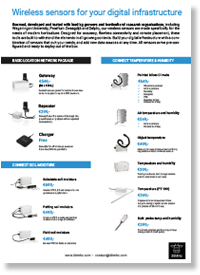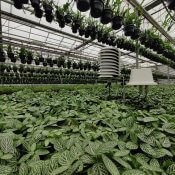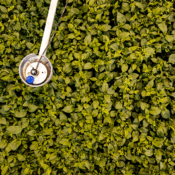Fine Tuning the components of IPM: a conversation with Fargro’s Ant Surrage
 Ant Surrage is a technical development specialist at Fargro. We spoke with him about integrated pest management, the challenges facing greenhouse growers, and where technology — and most importantly, data — can help inform strategy and fight disease.
Ant Surrage is a technical development specialist at Fargro. We spoke with him about integrated pest management, the challenges facing greenhouse growers, and where technology — and most importantly, data — can help inform strategy and fight disease.
What are the challenges growers face when developing an IPM strategy?
Application uncertainty has been a big problem for the industry, though there has been significant information produced by research bodies such as the AHDB and Warwick crop centre on how to best apply biopesticides as part of the AMBER project. However, new technologies and their increasing adoption within the industry give possibilities for further information to be produced on how to best apply biopesticides based on environmental data.
Firstly, having a higher resolution picture of the environmental conditions within a cropped area can allow for the detection of areas with “Goldilocks” conditions. Those being areas that are at a higher risk for pest and disease establishment. Growers can, therefore, be highly proactive with their monitoring of these areas, and as such, can spot treat with IPM compatible biopesticides at very early signs of pest and disease.
To give an example, on a nursery I worked on we often had situations when grey mould (botrytis) would take hold in a corner of a glasshouse in a cyclamen crop and then migrate up through the crop. It is of no doubt to me now that the homogenous environment that we assumed was present was not. The corner must have been a “Goldilocks” zone for the disease to establish. Having a more granular environmental picture would have allowed for early identification of this, therefore meaning either the conditions could be changed, or area could be treated with a preventative spray.
Secondly the effects of environmental conditions on the pest and in turn how this affects the efficacy of products. Dr Dave Skirvin of ADAS is developing a “boxcar train” model to describe pest populations increase. A key factor is environmental conditions and the effects these have on the developmental stages of a pest and intern biopesticide efficacy. Some biopesticides take 5-7 days to take effect, if the environmental conditions are such that reproduction in a developmental stage is less than 5-7 days then the pest will be able to reproduce before death. Having large amounts of data centralised on a single dashboard allows for a grower to easily keep track of the environmental changes that may influence pest population dynamics.
30MHz Sensor Catalogue
 Designed for accuracy, flawless connectivity and remote placement, these tools are built to withstand the elements in all growing contexts. Build your digital infrastructure with a combination of sensors that suit your needs, and add new data sources at any time. Our wireless sensors are made specifically for the needs of modern horticulture.
Designed for accuracy, flawless connectivity and remote placement, these tools are built to withstand the elements in all growing contexts. Build your digital infrastructure with a combination of sensors that suit your needs, and add new data sources at any time. Our wireless sensors are made specifically for the needs of modern horticulture.
All sensors arrive pre-configured and ready to deploy out of the box.
Download the 30MHz Sensor Catalogue
How can understanding changes in the environment improve IPM efficacy?
Many biopesticides are living organism and as such have certain conditions under which they work best. Take for example Naturalis L which is a product containing a fungus called Beauveria bassiana, the label states that the product is active from 10-37 ºC and above a relative humidity of 50%. Actually, we know that to see the best efficacy the product should be applied between 20 – 30 ºC and with a relative humidity over 60%, sporulation only occurs above 80% relative humidity. On a diurnal basis this is a relatively narrow window of time, however, having real-time alters notifying you as to when conditions are perfect at crop level allows for a grower to be confident that they are applying the product in the optimum conditions.
I also think the improved ability to share ideas and collaborate with others is going to be revolutionary. Not only in how quickly and accurately we will be able to advise on crops, but also the ability for innovative solutions and management strategies to be shared in our community.
This, of course, all forms part of an IPM programme. HortAmericas explains excellently how macro biological controls can be optimised through environmental conditions and we should remember that by altering our environmental conditions through ventilation, screening, irrigation can greatly prevent pest and disease establishment. However, we are seeing now that the separate components of IPM can be fine-tuned with new tech and data creating overall more effective programmes with a reduced need for conventional chemistry.
If you want to know how to optimise other biopesticides contact the Fargro technical team.
Monitor crop-level and climate insights in one platform
 Do you want to work towards a greater understanding of what your crops are doing rather than what the climate around your crops is doing?
Do you want to work towards a greater understanding of what your crops are doing rather than what the climate around your crops is doing?
30MHz Digital Complete combines macro and micro climate data and uses measurements directly from your crops to monitor their health. We can connect your climate computer and various crop-level sensors to your private wireless network and feed all your data into your account within our platform.
Download the information about Digital Complete


30MHz is typing… Our extended support team is ready to chat!
At 30MHz we think it’s important that our users can use our platform in an optimal way. At times you may have questions and you would like some help from our support team. Email and our support page filled with helpful articles were your go to’s. But we thought it was time for something extra… ...Read more
New 30MHz connect casing: How we protect your tech
To make sure your dataflow is fully protected, 30MHz introduces a new connect casing: waterproof, dust proof and even resistant to hits. This special shield will last longer and ensure a reliable dataflow from the connected sensor. What does that full protection mean? That’s what we will explain in this article. Watertight: resistant to wetness ...Read more
Most popular sensors for your greenhouse
As a grower, you know that optimal crop development starts with precise monitoring of your cultivation environment. But how do you transform raw data into actionable insights for your crops? This is where our wireless sensors and the 30MHz platform come together. Our sensors measure essential variables such as VPD, dew point, moisture deficit, EC, ...Read more


